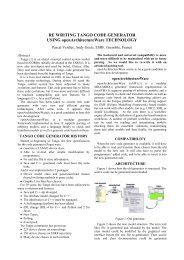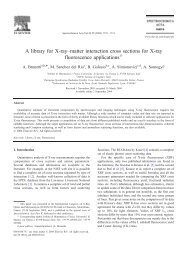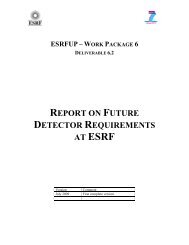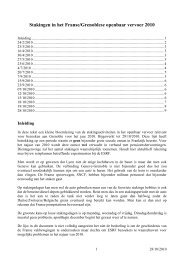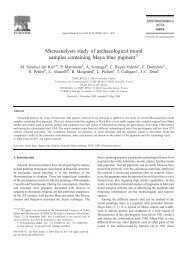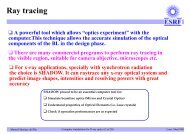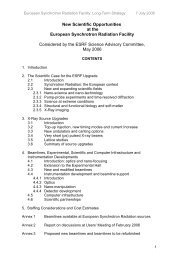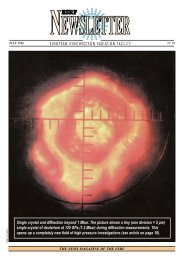A method for detailed simulations of neutron diffraction from ... - ESRF
A method for detailed simulations of neutron diffraction from ... - ESRF
A method for detailed simulations of neutron diffraction from ... - ESRF
You also want an ePaper? Increase the reach of your titles
YUMPU automatically turns print PDFs into web optimized ePapers that Google loves.
Nuclear Instruments and Methods in Physics Research A 529 (2004) 231–233<br />
A <strong>method</strong> <strong>for</strong> <strong>detailed</strong> <strong>simulations</strong> <strong>of</strong> <strong>neutron</strong> <strong>diffraction</strong><br />
<strong>from</strong> imperfect crystals<br />
L. Alianelli a,b, *, N. Wilson b , K.H. Andersen b ,M.S!anchez del R!ıo c , R. Felici a<br />
Abstract<br />
a Istituto Nazionale Fisica della Materia, Operative Group in Grenoble c/o <strong>ESRF</strong>, BP 220, 38043 Grenoble, France<br />
b Institut Laue-Langevin BP 156, 38042 Grenoble, France<br />
c European Synchrotron Radiation Facility BP 220, 38043 Grenoble, France<br />
An upgraded version <strong>of</strong>the McStas Monochromator-curved module is presented. The new component, called<br />
Monochromator-reflect, is based on the use <strong>of</strong>input files <strong>for</strong> interpolating the <strong>neutron</strong> reflection and transmission<br />
probabilities according to the theoretical reflectivity <strong>of</strong>the crystal. These probabilities depend on the energy and angle<br />
at the crystal surface and also on the crystal mosaicity, geometry, material scattering cross-section, attenuation<br />
coefficient, and Bragg planes. We present details <strong>of</strong> the algorithm and definitions which are essential <strong>for</strong> a correct use <strong>of</strong><br />
the module and show the improvements that it <strong>of</strong>fers.<br />
r 2004 Elsevier B.V. All rights reserved.<br />
PACS: 03.75.B; 07.05.T<br />
Keywords: Neutron optics; Imperfect crystals; Simulation <strong>method</strong>s<br />
1. Introduction<br />
McStas [1] is a widely used tool <strong>for</strong> the<br />
simulation and design <strong>of</strong><strong>neutron</strong> instruments. It<br />
exploits a large component library, a part <strong>of</strong>which<br />
results <strong>from</strong> users’ original contributions or<br />
upgrade <strong>of</strong>existing modules. A crucial part <strong>of</strong><br />
the instrument simulation is, in many cases, the<br />
*Corresponding author. Istituto Nazionale Fisica della<br />
Materia, Operative Group in Grenoble c/o <strong>ESRF</strong>, BP 220,<br />
38043 Grenoble, France. Tel.: +33-4-76-20-70-19; fax: +33-4-<br />
76-20-77-00.<br />
E-mail address: lucia.alianelli@ill.fr (L. Alianelli).<br />
ARTICLE IN PRESS<br />
0168-9002/$ - see front matter r 2004 Elsevier B.V. All rights reserved.<br />
doi:10.1016/j.nima.2004.04.161<br />
exact computation <strong>of</strong>the monochromator or<br />
analyser crystal reflectivity, which defines the<br />
monochromated intensity and the resolution in<br />
reciprocal space. In this work we present a new<br />
crystal component, called Monochromator-reflect<br />
[2]. It is based on Monochromator-curved [3], with<br />
an improved treatment <strong>of</strong>the reflectivity, and<br />
allowing a <strong>detailed</strong> description <strong>of</strong>crystals with<br />
mosaicity <strong>of</strong>the Bragg planes and spatial variation<br />
<strong>of</strong>the d-spacing. The focusing slab geometry,<br />
which is well described in Monochromator-curved,<br />
has not been modified. None <strong>of</strong>the two versions is<br />
appropriate <strong>for</strong> simulating elastically bent perfect<br />
crystals. Neither imperfect crystals in asymmetric
232<br />
or transmission geometry are included. We<br />
carry out a benchmarking <strong>of</strong>the component by<br />
comparison with the Monochromator-curved<br />
component.<br />
2. Computation <strong>method</strong> and examples<br />
Monochromator-curved is a ray-tracing module,<br />
i.e. a code in which the Monte Carlo <strong>method</strong> is<br />
used to choose the fate <strong>of</strong> a ray impinging on the<br />
crystal. The crystal has no thickness, hence the<br />
beam penetration and secondary extinction are not<br />
simulated. There are two input parameters required<br />
<strong>for</strong> describing the crystal reflectivity: peak<br />
reflectivity R0 and mosaicity mosaic. These are<br />
used to build a probability distribution <strong>of</strong>the<br />
reflected rays versus the grazing angle. In Monochromator-curved,<br />
the input parameter mosaic is<br />
the full-width at half-maximum (FWHM) <strong>of</strong> the<br />
reflectivity pr<strong>of</strong>ile. The same parameter mosaic is<br />
used <strong>for</strong> sampling the additional divergence <strong>of</strong> the<br />
outgoing beam. Hence, in the original Monochromator-curved<br />
code, there is not a clear distinction<br />
<strong>of</strong> the difference between the two different<br />
concepts <strong>of</strong>mosaicity and FWHM <strong>of</strong>the reflectivity<br />
pr<strong>of</strong>ile. In the new component, we use a<br />
more suitable definition <strong>of</strong>mosaicity: Z is the<br />
intrinsic mosaicity, i.e. the FWHM <strong>of</strong>the angular<br />
ARTICLE IN PRESS<br />
L. Alianelli et al. / Nuclear Instruments and Methods in Physics Research A 529 (2004) 231–233<br />
Fig. 1. Divergence pr<strong>of</strong>iles after reflection by a mosaic crystal<br />
Cu 220 with yBragg ¼ 37:5 ; Z ¼ 10 0 B0:17 ; simulated with<br />
Monochromator-reflect (solid lines) and Monochromatorcurved<br />
(dotted and dashed lines). The incident beam is highly<br />
collimated and non monochromatic. TOP: Monochromatorreflect<br />
gives a vertical divergence distribution with FWHM<br />
equal to 0:20 ¼ 2Z sin y: The pr<strong>of</strong>ile calculated with Monochromator-curved<br />
has FWHM <strong>of</strong>0:33 : This result is due to the<br />
ambiguous definition <strong>of</strong>mosaicity in Monochromator-curved,<br />
i.e. FWHM <strong>of</strong>the reflectivity curve, rather than intrinsic<br />
mosaicity. The dashed curve, obtained by using mosaic ¼ Z as<br />
input parameter <strong>for</strong> Monochromator-curved, provides the<br />
correct outgoing vertical divergence. BOTTOM: the FWHMs<br />
<strong>of</strong>the horizontal divergence distributions agree well, except that<br />
the Monochromator-curved simulated data have a Gaussian<br />
shape (the fit is not shown), which in general does not<br />
correspond to reality. The horizontal resolution, in fact, is<br />
determined by the shape <strong>of</strong>reflectivity. The use <strong>of</strong>mosaic ¼ Z<br />
with Monochromator-curved (dashed line) gives a smaller<br />
divergence.<br />
distribution <strong>of</strong>the small perfect crystallites in the<br />
mosaic crystal. The theory [4] shows that the<br />
FWHM and peak value <strong>of</strong>the reflectivity pr<strong>of</strong>ile<br />
are functions <strong>of</strong> the crystal intrinsic mosaicity Z;<br />
but depend also on other parameters, like thickness,<br />
scattering and attenuation factors. It is<br />
important, there<strong>for</strong>e, when simulating a mosaic<br />
crystal, to use weight distributions (or reflectivities)<br />
that have the correct dependence on energy<br />
and angle. This is not possible when using<br />
Monochromator-curved. Concerning the angular<br />
Intensity [a.u.]<br />
Intensity [a.u.]<br />
2.5 10 -6<br />
2.0 10 -6<br />
1.5 10 -6<br />
1.0 10 -6<br />
5.0 10 -7<br />
1.5 10 -6<br />
1.0 10 -6<br />
5.0 10 -7<br />
Monochromator_reflect<br />
Monochromator_curved, mosaic = 0.27 deg<br />
Monochromator_curved, mosaic = 0.17 deg<br />
0<br />
-1.0 -0.5 0.0 0.5 1.0<br />
Vertical divergence [deg]<br />
Monochromator_reflect<br />
Monochromator_curved, mosaic = 0.27 deg<br />
Monochromator_curved, mosaic = 0.17 deg<br />
0<br />
-1.0 -0.5 0.0 0.5 1.0<br />
Horizontal divergence [deg]
ehaviour, we recall that the reflectivity does not<br />
necessarily follow a Gaussian pr<strong>of</strong>ile, as assumed<br />
in Monochromator-curved, even when the mosaic<br />
distribution is a Gaussian. In Monochromatorreflect<br />
we use input files <strong>for</strong> the reflectivity, that are<br />
created by a program [5] that provides the<br />
analytical solutions <strong>of</strong>the Darwin equations [6],<br />
with the possibility to correct <strong>for</strong> primary extinction.<br />
The reflectivity pr<strong>of</strong>iles include secondary<br />
extinction and have the correct theoretical dependence<br />
on all the crystal parameters: material crosssection<br />
and attenuation coefficient, Bragg planes,<br />
Debye-Waller factor, mosaicity and grazing angle<br />
y: As stated above, a correct definition <strong>of</strong><br />
mosaicity is important, not only because it<br />
determines the reflectivity, but also because it<br />
produces an additional angular spread <strong>of</strong>the<br />
beam.<br />
In the ideal case <strong>of</strong>a perfectly collimated<br />
incident beam, the divergence <strong>of</strong>the reflected<br />
beam in the plane perpendicular to the scattering,<br />
is equal to 2Z sin y: This result can be explained by<br />
geometrical arguments and has been confirmed by<br />
<strong>detailed</strong> <strong>simulations</strong> using the Monte Carlo<br />
<strong>method</strong> applied to the beam interaction with the<br />
microscopic crystallites <strong>for</strong>ming a mosaic crystal<br />
[7]. This is clearly seen in Fig. 1, where a mosaic<br />
copper 220 is set to reflect a collimated and non<br />
monochromatic <strong>neutron</strong> beam with laverage ¼<br />
1:6 ( A: The mosaic distribution is a Gaussian with<br />
Z ¼ 10 0 B0:17 : The simulation per<strong>for</strong>med with<br />
Monochromator-reflect shows that the average<br />
vertical divergence (top) <strong>of</strong>the beam increases to<br />
0:20 ¼ 2Z sin y; whereas Monochromator-curved<br />
gives 0:33 : In both cases, the pr<strong>of</strong>iles are<br />
Gaussians. The horizontal divergence depends on<br />
the shape <strong>of</strong>reflectivity versus energy and angle.<br />
The Monochromator-curved data (Fig. 1, bottom)<br />
have a Gaussian behaviour which does not<br />
correspond to reality. It is seen that, even <strong>for</strong> the<br />
simple case <strong>of</strong>an isotropic mosaic crystal, Monochromator-curved<br />
cannot exactly reproduce the<br />
horizontal and vertical beam divergence at the<br />
same time.<br />
For the case <strong>of</strong>anisotropic mosaic crystals, the<br />
description in Monochromator-curved is even<br />
more unrealistic. In these crystals, in fact, the<br />
peak reflectivity and the FWHM depend on the<br />
ARTICLE IN PRESS<br />
L. Alianelli et al. / Nuclear Instruments and Methods in Physics Research A 529 (2004) 231–233 233<br />
azimuth, i.e. the f rotation <strong>of</strong>the crystal around<br />
the <strong>diffraction</strong> vector. The input files used in<br />
Monochromator-reflect contain reflectivity in the<br />
horizontal and vertical planes and hence give more<br />
realistic results. The upgraded McStas module<br />
allows also the simulation <strong>of</strong>crystals with a<br />
variation <strong>of</strong>the d-spacing. The REF.pro [5] code<br />
can provide input files with the correct de<strong>for</strong>med<br />
crystal reflectivities. For this, it uses an algorithm<br />
developed in the framework <strong>of</strong> the layer-coupling<br />
model [8], allowing a solution <strong>of</strong>the Darwin<br />
equations in layered media.<br />
3. Conclusions<br />
The use <strong>of</strong>Monochromator-reflect allows better<br />
<strong>simulations</strong> <strong>of</strong>imperfect crystals with McStas.<br />
When used together with the REF.pro program,<br />
gradient and mosaic (isotropic and anisotropic)<br />
crystals can be accurately modeled. This description<br />
includes, by definition, secondary extinction.<br />
Primary extinction can also be simulated, if<br />
appropriate correction factors are used. The<br />
penetration <strong>of</strong><strong>neutron</strong>s in the bulk crystal, and<br />
the consequent spread <strong>of</strong>the beam at the exit<br />
surface due to secondary extinction, is not<br />
simulated because <strong>of</strong>the infinitely thin crystal<br />
approximation. Hence, a further improvement <strong>of</strong><br />
the code, with thickness included, is envisaged.<br />
Moreover, other geometrical details will be added,<br />
allowing the simulation <strong>of</strong>asymmetric reflections,<br />
including Laue (or transmission) geometry, that<br />
are <strong>of</strong>ten used in <strong>neutron</strong> instruments.<br />
References<br />
[1] http://<strong>neutron</strong>.risoe.dk/mcstas/<br />
[2] N. Wilson, ILL Stage Report, 2003.<br />
[3] http://<strong>neutron</strong>.risoe.dk/download/components/optics/<br />
Monochromator-curved.html<br />
[4] W.H. Zachariasen, Theory <strong>of</strong> X-ray Diffraction in Crystals,<br />
Dover, New York, 1945.<br />
[5] L. Alianelli, ILL Technical Report ILL03AL05T, 2003.<br />
[6] V.F. Sears, Acta Crystallogr. A 53 (1997) 35.<br />
[7] L. Alianelli, PhD Thesis, Universit!e Joseph Fourier,<br />
Grenoble, France, published by dissertation.de, 2002.<br />
[8] H.C. Hu, J. Appl. Crystallogr. 25 (1992) 731.



